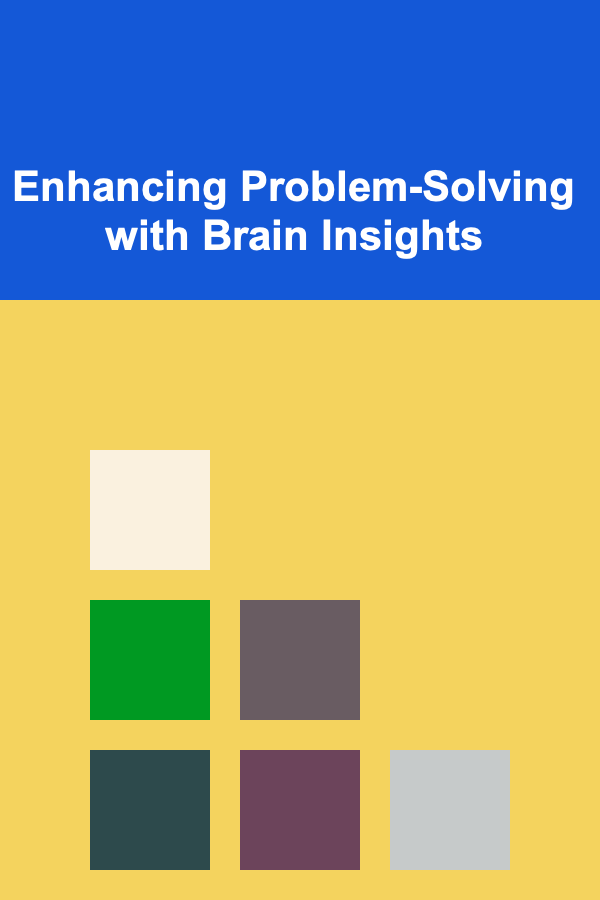
Enhancing Problem-Solving with Brain Insights
ebook include PDF & Audio bundle (Micro Guide)
$12.99$7.99
Limited Time Offer! Order within the next:

Problem-solving is a fundamental cognitive skill crucial for success in virtually every aspect of life, from navigating everyday challenges to driving innovation in professional settings. While traditional problem-solving methodologies often focus on structured processes and logical reasoning, understanding the underlying neurological mechanisms can significantly enhance our ability to approach and overcome complex issues. This article delves into how insights from neuroscience can be leveraged to improve problem-solving, exploring brain regions involved, cognitive processes at play, and practical strategies for optimizing problem-solving performance.
The Neuroscience of Problem-Solving: Key Brain Regions and Processes
Effective problem-solving is not confined to a single brain region; it's a distributed process involving a complex interplay of several areas working in concert. Understanding these key players provides a foundation for developing targeted strategies to improve problem-solving abilities.
The Prefrontal Cortex (PFC): Executive Function and Cognitive Control
The prefrontal cortex (PFC), particularly the dorsolateral prefrontal cortex (dlPFC) and the ventrolateral prefrontal cortex (vlPFC), is the central hub for executive functions. These functions are critical for problem-solving and include:
- Working Memory: Holding and manipulating information in mind, essential for planning and considering different solutions.
- Cognitive Flexibility: Shifting between different perspectives and adapting to changing circumstances. This is crucial for overcoming mental rigidity and exploring novel approaches.
- Inhibition: Suppressing irrelevant thoughts and impulses that can hinder focused problem-solving. This allows for concentration on the task at hand.
- Planning and Decision-Making: Organizing steps towards a goal and evaluating the potential consequences of different actions.
Damage to the PFC can significantly impair problem-solving abilities, highlighting its critical role in these cognitive processes.
The Anterior Cingulate Cortex (ACC): Conflict Monitoring and Error Detection
The anterior cingulate cortex (ACC) plays a crucial role in monitoring conflict and detecting errors. When encountering a problem, the ACC identifies the discrepancy between the current state and the desired state. It also signals when a chosen strategy is failing, prompting the brain to adjust its approach. This feedback loop is essential for iterative problem-solving and learning from mistakes.
The Hippocampus: Memory and Retrieval
The hippocampus is vital for memory formation and retrieval. Problem-solving often involves drawing upon past experiences and knowledge. The hippocampus enables us to access relevant information, identify patterns, and apply previously successful solutions to new challenges. A strong memory system allows for efficient retrieval of information needed for analysis and decision-making.
The Amygdala: Emotional Regulation
While often associated with negative emotions like fear and anxiety, the amygdala also plays a role in emotional processing and can influence problem-solving. High levels of stress or anxiety can impair PFC function, hindering executive functions and reducing problem-solving effectiveness. Managing emotions and maintaining a calm, focused state is therefore crucial for optimal problem-solving performance. Positive emotions, on the other hand, can broaden thinking and encourage creative solutions.
The Parietal Lobe: Spatial Reasoning and Attention
The parietal lobe contributes to problem-solving through its involvement in spatial reasoning, attention, and integrating sensory information. Visual-spatial problems, such as puzzles or engineering challenges, heavily rely on the parietal lobe's ability to mentally manipulate objects and understand spatial relationships. Furthermore, the parietal lobe plays a role in directing attention to relevant aspects of the problem, filtering out distractions.
Cognitive Processes Influenced by Brain Function
Understanding the brain regions involved in problem-solving leads to insights into the specific cognitive processes that underpin this complex skill. These processes can be broadly categorized and targeted for improvement.
Attention and Focus
Effective problem-solving requires sustained attention and the ability to focus on relevant information while filtering out distractions. The PFC and parietal lobe work together to control attention. Strategies to improve attention include:
- Mindfulness Meditation: Training attention to the present moment and reducing mind-wandering.
- Environmental Optimization: Minimizing distractions in the work environment.
- Time Management Techniques: Using techniques like the Pomodoro Technique to maintain focus during concentrated work periods.
Working Memory Capacity
Working memory is the mental workspace where information is actively held and manipulated. A larger working memory capacity allows for more complex problem-solving. Strategies to improve working memory include:
- Dual N-Back Training: A cognitive training exercise designed to improve working memory capacity.
- Chunking: Organizing information into meaningful chunks to reduce the cognitive load on working memory. For example, instead of remembering the phone number 5551234567 as ten individual digits, chunk it as 555-123-4567.
- Visualization: Using mental imagery to represent information and facilitate recall.
Cognitive Flexibility
Cognitive flexibility is the ability to switch between different perspectives and adapt to changing circumstances. It is crucial for overcoming mental fixedness and exploring novel solutions. Strategies to improve cognitive flexibility include:
- Perspective-Taking Exercises: Actively considering different viewpoints on a problem.
- Brain Teasers and Puzzles: Engaging in activities that require flexible thinking and creative problem-solving.
- Learning New Skills: Challenging the brain and forcing it to adapt to new information and processes.
Pattern Recognition
Identifying patterns is a fundamental aspect of problem-solving. The ability to recognize recurring themes and relationships allows for efficient problem-solving and prediction. Strategies to improve pattern recognition include:
- Practice with Pattern Recognition Tasks: Engaging in activities that specifically target pattern recognition skills, such as visual puzzles or coding challenges.
- Data Analysis: Analyzing data sets to identify trends and correlations.
- Mind Mapping: Visually representing information to identify relationships and patterns.
Emotional Regulation
Managing emotions and maintaining a calm, focused state is crucial for optimal problem-solving performance. High levels of stress or anxiety can impair PFC function, hindering executive functions. Strategies to improve emotional regulation include:
- Mindfulness Meditation: Promoting self-awareness and emotional regulation.
- Deep Breathing Exercises: Reducing stress and promoting relaxation.
- Cognitive Reappraisal: Reframing negative thoughts and emotions in a more positive light.
Practical Strategies for Enhancing Problem-Solving Based on Brain Insights
Based on our understanding of the neuroscience of problem-solving, we can develop practical strategies to enhance our cognitive abilities and approach challenges more effectively. These strategies target specific brain functions and cognitive processes to optimize problem-solving performance.
Optimize Your Environment for Focus
Minimize distractions in your work environment to enhance attention and focus. This includes:
- Creating a Dedicated Workspace: Designating a specific area solely for work or problem-solving.
- Reducing Noise: Using noise-canceling headphones or earplugs to block out distractions.
- Eliminating Visual Distractions: Removing clutter and unnecessary items from your workspace.
- Turning Off Notifications: Disabling notifications on your phone and computer to avoid interruptions.
Practice Mindfulness Meditation
Regular mindfulness meditation can improve attention, emotional regulation, and working memory capacity. Mindfulness meditation involves focusing on the present moment without judgment. Even short daily sessions can have a significant impact.
Example Mindfulness Exercise:
- Find a quiet place to sit comfortably.
- Close your eyes and focus on your breath.
- Notice the sensation of the air entering and leaving your body.
- When your mind wanders, gently redirect your attention back to your breath.
- Continue for 5-10 minutes.
Engage in Cognitive Training Exercises
Cognitive training exercises can target specific cognitive functions, such as working memory, attention, and cognitive flexibility. Examples include:
- Dual N-Back Training: A working memory exercise that involves remembering a sequence of visual and auditory stimuli.
- Lumosity and other brain training apps: These apps offer a variety of games and exercises designed to improve cognitive skills. While their efficacy is debated, some individuals find them helpful.
- Sudoku and Crossword Puzzles: These activities challenge logic, reasoning, and pattern recognition.
Prioritize Sleep
Sleep is crucial for cognitive function and memory consolidation. During sleep, the brain processes and consolidates information, strengthening neural connections. Aim for 7-9 hours of quality sleep per night. Sleep deprivation can significantly impair problem-solving abilities.
Manage Stress and Anxiety
High levels of stress and anxiety can negatively impact PFC function and hinder problem-solving. Strategies to manage stress include:
- Regular Exercise: Releasing endorphins and reducing stress hormones.
- Spending Time in Nature: Reducing stress and improving mood.
- Social Support: Connecting with friends and family for emotional support.
- Deep Breathing Exercises: Activating the parasympathetic nervous system and promoting relaxation.
Promote Brain Health Through Diet and Exercise
A healthy diet and regular exercise are essential for maintaining optimal brain function. Consume foods rich in antioxidants, omega-3 fatty acids, and B vitamins. Engage in regular physical activity to improve blood flow to the brain and promote neurogenesis (the creation of new neurons). Consider these dietary and exercise tips:
- Mediterranean Diet: Rich in fruits, vegetables, whole grains, and healthy fats.
- Regular Aerobic Exercise: Improves cardiovascular health and brain function.
- Strength Training: Supports overall physical and cognitive health.
Break Down Complex Problems into Smaller, Manageable Steps
Large, complex problems can be overwhelming and intimidating. Breaking them down into smaller, more manageable steps can make them feel less daunting and easier to solve. This approach also allows you to focus on one aspect of the problem at a time, improving concentration and reducing cognitive overload.
Example: Solving a coding bug
- Identify the specific error message.
- Isolate the section of code causing the error.
- Use debugging tools to step through the code line by line.
- Research the error message online to find potential solutions.
- Test different solutions until the bug is fixed.
Use Visual Aids
Visual aids, such as diagrams, mind maps, and flowcharts, can help to organize information, identify relationships, and visualize potential solutions. These tools can be particularly helpful for visual learners and those with limited working memory capacity.
Embrace Creativity and Divergent Thinking
Don't be afraid to think outside the box and explore unconventional solutions. Encourage creativity and divergent thinking by brainstorming, generating multiple ideas, and challenging assumptions. Techniques like reverse brainstorming (identifying potential problems instead of solutions) can also be helpful.
Seek Feedback and Collaboration
Collaboration can provide different perspectives and insights that you might not have considered on your own. Seek feedback from others and be open to new ideas. Working with a team can also distribute the cognitive load and make the problem-solving process more efficient.
Reflect on Your Problem-Solving Process
After solving a problem, take time to reflect on your approach. What strategies worked well? What could you have done differently? By analyzing your problem-solving process, you can identify areas for improvement and develop more effective strategies for future challenges.
The Importance of Neuroplasticity
A key principle underlying the effectiveness of these strategies is neuroplasticity -- the brain's ability to reorganize itself by forming new neural connections throughout life. This means that through consistent effort and targeted practice, we can strengthen the brain regions and cognitive processes involved in problem-solving, leading to lasting improvements in our abilities. Neuroplasticity highlights the potential for continuous growth and adaptation in our cognitive skills, reinforcing the idea that problem-solving abilities can be significantly enhanced through conscious effort and brain-aware strategies.
Conclusion
By understanding the neuroscience of problem-solving and implementing targeted strategies, we can significantly enhance our cognitive abilities and approach challenges more effectively. By focusing on optimizing our environment, improving attention, managing stress, and engaging in cognitive training, we can strengthen the brain regions and cognitive processes involved in problem-solving. Embracing creativity, seeking feedback, and reflecting on our process further refine our problem-solving skills. Ultimately, by leveraging brain insights, we can unlock our full problem-solving potential and achieve greater success in all areas of life. The key is consistent effort and a commitment to continuous learning and improvement.

How to Create a Customer Feedback Management Checklist for Continuous Improvement
Read More
How to Create a Workshop Agenda that Keeps Participants Engaged
Read More
How to Make Money Online as a Pinterest Manager: 10 Actionable Ideas
Read More
How To Discover Emerging Neo-Classical Composers
Read MoreHow to Personalize Your Fertility Tracker Planner for Optimal Results
Read More
How to Integrate Mindfulness into Your Goal Setting Planner
Read MoreOther Products

How to Create a Customer Feedback Management Checklist for Continuous Improvement
Read More
How to Create a Workshop Agenda that Keeps Participants Engaged
Read More
How to Make Money Online as a Pinterest Manager: 10 Actionable Ideas
Read More
How To Discover Emerging Neo-Classical Composers
Read MoreHow to Personalize Your Fertility Tracker Planner for Optimal Results
Read More